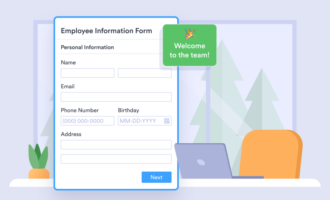When you’ve made a great new hire, it can be hard to tell who’s more excited — you or your new employee. To keep up the excitement of moving a candidate from prospect to employee, it’s important to provide a seamless and comfortable orientation process so they feel like they’re part of the team right away.
To do this, you should understand two truths about new employee onboarding. First, good onboarding translates to happier employees who tend to stay longer. A study by employee recognition software company O.C. Tanner found that great onboarding makes 69 percent of employees more likely to stay with a company for three years. That’s the good onboarding news.
The second bit of news is a little more complicated — a hefty majority of new hires find their onboarding experience lacking. A Gallup poll found that only 12 percent of employees would say their employer did a “great job” onboarding them. Put another way, 88 percent of employees found their orientation flawed, making them more likely to turn over faster.
Whether the problems are from handling complex information or mismanagement in the human resources department, you can avoid detrimental shortcomings in the employee orientation process. Here are a few ways to make your new hires feel more grounded in your workplace to ensure you have happy, involved staff who are keen to stick around.
How to improve the orientation process
Starting a new job is inherently hectic and overwhelming. It’s incumbent on you and your HR department to massage out as much of the early friction as you can. In getting your new team members started, you have to make sure they feel ready and that you’re considering their needs — which will translate into them being excited to be there.
Prepare hires ahead of time
The first day on the job is often exciting but quite daunting. It’s the adult version of a first day at school — entering a new environment can be a touch nerve-wracking for an employee. To alleviate the uneasiness, take the time to lay the groundwork for new hires before their first day even arrives.
The week or weekend before they start, give new hires employee manuals, background information on your company, and a schedule of events for their first day or week. This gives them a chance to review and learn about your business operations before they even set foot in the office as a full member of the team.
An employee who enters your organization with a strong understanding of the landscape feels more confident and is more likely to fly through your orientation. They also tune in more quickly to how your team functions.
Make them feel welcome
A new member of your company can easily get lost in the shuffle of hiring and onboarding, especially when you’re bringing on several hires at once. Tailoring the process to make it more focused on the individual makes for a much more poised employee.
To do this, work with HR and other departments to set up one-on-ones with all essential teams. For example, let’s say you’re a beer company that’s just hired a new salesperson. Since they’re expected to be an external representative of your company, you want to have as thorough an onboarding process as possible.
Within the first week and regularly through their first few months, this new employee should have one-on-one meetings with the marketing team, the warehouse staff, the brewers, the bottling line, and so on.
With their integral understanding of the operations of the business, this salesperson will come out of orientation feeling much more self-assured than someone given a shorter run of the process. Set up these meetings early and often, and a new employee will more naturally feel like they’re an essential part of your operations.
Give them an engaging first day
Your orientation process doesn’t have to be a slog. Get your new hires fired up on that first day or first week and show them your company is an exciting place to be. Plan activities and exercises — simple team-building tasks, an employee lunch, or other icebreakers — that feel less like work and more like becoming part of something bigger. Support systems such as guided onboarding can also help the first day feel organized but still enjoyable, and give new hires both direction and a sense of excitement as they get started.
These bouts of engagement are proven to be helpful off the bat. Human resources company BambooHR found that 33 percent more of the workforce felt engaged when the organization had effective onboarding. Cultivating a sense of involvement and camaraderie from the get-go is important to the longevity of your employees, and, by extension, your entire organization.
Pro Tip
Want to give new hires a consistent, engaging start? Use Jotform Presentation Agents to create AI-powered, narrated presentations that walk employees through orientation at their own pace, with the option to ask questions and get instant answers.
Automate the process
An automated orientation process is a seamless orientation process. Invest time and effort in the back end, and you’ll find yourself with a much faster onboarding experience.
You can automate several orientation steps, especially those that are detail and information heavy or that normally require manual processes to complete.
One easy solution is Jotform’s online Form Builder. You can customize form templates for new hires to complete onboarding, register for necessary training, answer questions about themselves, and submit check-in surveys. HR teams can customize surveys and orientation templates of their own to individualize the onboarding process as well as implement these forms into their software with integrations.
HR teams can also use Jotform Tables to track employees through the onboarding process, make sure they get the right training, and maintain employee information. You can manage form information from one database, making it easy to handle even multiple hires at a time so none of them are left waiting.
Beyond the more obvious employee-facing materials, Jotform Workflows expedites manager sign-off of hiring paperwork and training requests so major decision-makers stay in the loop during onboarding. When you automate the more tedious parts of your orientation process, you can focus your new employee experience around a relationship — not paperwork.
With new hire orientation, you project a lasting impression of your company beyond the initial interview. If you can make the experience helpful, positive, and worthwhile, you’ll set your team up for success, reduce turnover, and promote a happy workforce.
























Send Comment: